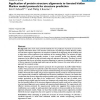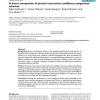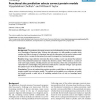158 search results - page 17 / 32 » Complementarity of network and sequence information in homol... |
RECOMB
2007
Springer
14 years 9 months ago
2007
Springer
Abstract. Sequence to structure alignment is an important step in homology modeling of protein structures. Incorporation of features like secondary structure, solvent accessibility...
BMCBI
2006
13 years 8 months ago
2006
Background: One of the most powerful methods for the prediction of protein structure from sequence information alone is the iterative construction of profile-type models. Because ...
BMCBI
2007
13 years 8 months ago
2007
Background: Phylogenetic profiles record the occurrence of homologs of genes across fully sequenced organisms. Proteins with similar profiles are typically components of protein c...
BMCBI
2006
13 years 8 months ago
2006
Background: Recent technological advances have enabled high-throughput measurements of protein-protein interactions in the cell, producing large protein interaction networks for v...
BMCBI
2008
13 years 8 months ago
2008
Background: The prediction of protein structure can be facilitated by the use of constraints based on a knowledge of functional sites. Without this information it is still possibl...




